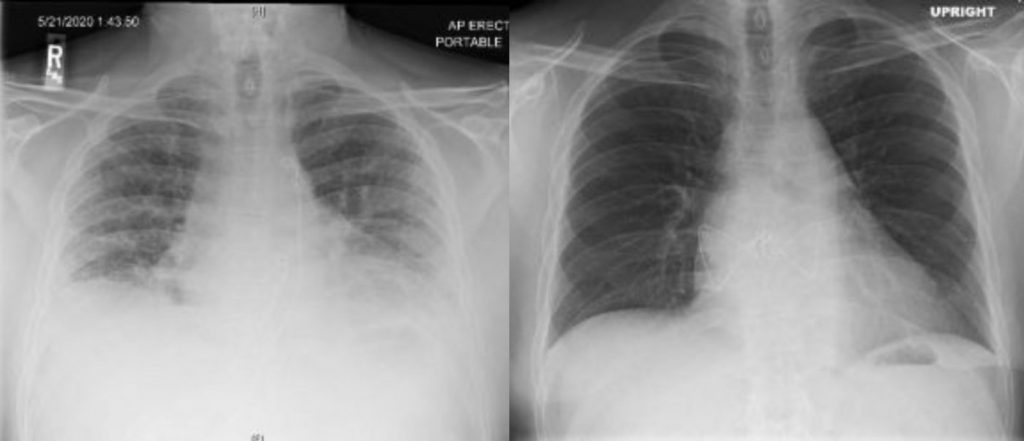Receiving My Diagnosis and Hopping on the IPF Roller Coaster

In 2014, I was living my life without a care in the world. Oh, I had a few health issues, but none that worried me at the time. Therefore, I had scheduled a vacation in Sweden for July. Little did I know I would soon be “Riding the IPF Roller Coaster.”
During a routine pulmonary visit that May, my wife, Dana, and I expected to hear that my lungs were good. We could not have been more wrong. I was diagnosed with idiopathic pulmonary fibrosis (IPF).
Human roller coaster. (Video by Dana Olson)
Journeying to an IPF diagnosis
Let me digress. My lung issues started long before my diagnosis. It takes IPF patients an average of two years to obtain a diagnosis, and my case was no different.
In 2011, I had two pulmonary embolisms of unknown origin. I continued to have problems with my lungs. On Labor Day 2012, I was working out on my elliptical machine and started coughing up blood. We went to the emergency room and they admitted me to the hospital. I saw a pulmonologist for the first time in my life. He mentioned three possible causes and the likelihood of each.
- Pneumonia (95%)
- A side effect of warfarin, a blood thinner (4%)
- Lung cancer (1%)
I had infiltrates in my lungs, and the most likely cause was pneumonia. Emotionally, I was more concerned about the possibility of having lung cancer. This concern was greater than that of any other diagnosis. It would be a long shot for me to develop lung cancer, but those two words scare me. Riding a roller coaster can be scary.
I was taken off warfarin. The pulmonologist treated me for pneumonia and wanted to track the infiltrates. So, he scheduled me for a series of computerized tomography (CT) scans. Over the next two years, I had three more CT scans, each showing infiltrates. A significant amount remained.
My pulmonologist wanted to see me one more time in 2014 after another CT scan. He’d found that my pneumonia in 2012 had masked my IPF, which made it hard to diagnose.
My 2014 IPF diagnosis
At my pulmonologist visit in May of 2014, my wife and I presumed that all the infiltrates in my lungs were gone, though I remember that I had been more fatigued around that time. My pulmonologist reviewed the CT scan results with us. He proceeded to tell us that his diagnosis was pulmonary fibrosis.
Up to this point in my life, I had never heard of PF, but Dana knew about it because her dad had died from it in the 1990s. Dana and I were shellshocked. We had not expected this diagnosis. I started searching the internet, and read that some people would rather have lung cancer than pulmonary fibrosis!
My pulmonologist did some tests, including autoimmune tests, to try to determine what type of PF I might have. After that, I do not remember talking about environmental or other causes of PF. He mentioned doing a lung biopsy, then left the decision to me. Some people do it, some do not.
My autoimmune tests were negative, meaning an autoimmune disease had not caused my PF. I did not follow up with my pulmonologist regarding possible other causes. Denial and avoidance hit me. After that, I had a lung biopsy. Ultimately, I learned my PF was idiopathic.
The last thing my pulmonologist mentioned to me was that, at 60, I was young enough to have a lung transplant. Wow, what a bombshell. Heck, I did not even know what pulmonary fibrosis was, let alone the prognosis or treatment options. Time proved him right: I received a lung transplant six years later.
Living with IPF
My loved ones and I have experienced many ups, downs, and twists. When I was told that I had PF and would possibly need a lung transplant, we entered our roller-coaster car. Our roller-coaster car moved slowly to the top of the first hill. Suddenly, we were over the top and gaining speed. We were going down the track’s steep slope toward the vertical loop.
My West Point classmates Greg and Paul have participated in my IPF journey. Greg and Paul, and their wives Barbara and Linda, are close friends. As we were going through my lung transplant evaluation, Greg wrote, “It was like a wild roller coaster ride.” So, my column is dedicated to “Riding the IPF Roller Coaster.”
Ride along with me on my future roller coaster inversions.
***
Note: Pulmonary Fibrosis News is strictly a news and information website about the disease. It does not provide medical advice, diagnosis, or treatment. This content is not intended to be a substitute for professional medical advice, diagnosis, or treatment. Always seek the advice of your physician or other qualified health provider with any questions you may have regarding a medical condition. Never disregard professional medical advice or delay in seeking it because of something you have read on this website. The opinions expressed in this column are not those of Pulmonary Fibrosis News or its parent company, Bionews, and are intended to spark discussion about issues pertaining to pulmonary fibrosis.








Leave a comment
Fill in the required fields to post. Your email address will not be published.